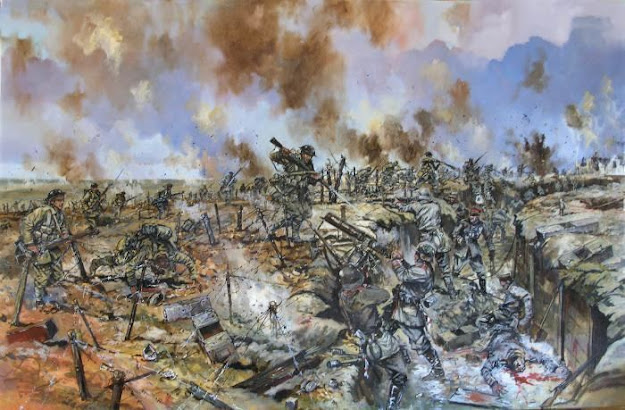 |
| Capture of Schwaben Redoubt in 1916 |
With Remembrance Day coming up soon, here is a story about a Bancroft man from Sowerby Bridge in Halifax who lost his life in WW1.
John Bancroft, the son of Geoffrey Thompson Bancroft and his wife Lavinia [nee: Bottomley] was born in Sowerby Bridge on 10th October 1896, one of three children the couple had. His father, Geoffrey, was a well-known music teacher of the piano and cornet in the area and also played in the local brass band.
The 1911 census shows the family living at 8 Wakefield Road in Sowerby Bridge, with John working at the age of 14 years as a “Bobbin Taker for a Worsted Spinner” which was a common job for children, doing basic tasks in local mills.
 |
| 1911 census |
In 1914 he was soon promoted to ‘Assistant Overlooker’ in the spinning mill of Alfred Brearley & Co and his life changed forever when on 14th August 1914 he was called up and served as a private with the 1st/4th Battalion Duke of Wellington’s West Riding Regiment.
 |
| Attestation Certificate |
After a period of training, he sailed from Folkestone to France on 15th April 1915
He was reported missing in action on 3rd September 1916 in a failed attack on Schwaben Redoubt and the desperately sad fact in all this tragedy is that his death was only officially confirmed to his family when it was listed with many others in the Halifax newspaper in 23rd June 1917 shown below, nine months after it occurred. [apologies for the poor quality of the picture]
John was awarded the 'Victory' and 'Star' medals, as the following military record shows, and the statement on it "Presumed dead 3.9.16" is a sad statement.
 |
| Medal record |
The Redoubt was a German strong point 500–600 yds (460–550 m) long and 200 yd (180 m) wide, built in stages since 1915, near the village of Thiepval and overlooking the River Ancre. It formed part of the German defensive system in the Somme sector of the Western Front during the WW1 and consisting of a mass of machine-gun emplacements, trenches and dug-outs. The Redoubt was defended by the 26th Reserve Division, south-west Germany, which had arrived in the area during the First Battle of Albert in 1914. Troops of the 36th (Ulster) Division captured the Redoubt on 1 July 1916, until forced out by German artillery-fire and counter-attacks after dark. The British kept the area of the Redoubt under bombardment until 3 September, when the 49th (West Riding) Division attacked the area from the west, in a morning fog, which is when John Bancroft was killed. The 36th (Ulster) Division infantry got across no man's land but were defeated when German artillery and machine gun-fire swept the Irish troops as German infantry counter-attacked from the flanks, using hand grenades. In late September, the British gained a footing in the Redoubt during the Battle of Thiepval Ridge (26–28 September). Attack and counter-attack followed until 14 October, when troops of the 39th Division, captured the last German foothold in the Redoubt and repulsed German counter-attacks from 15 to 21 October. The site of the Redoubt lies between the Thiepval Memorial and the Ulster Tower.
 |
| Bolton Brow Sunday School |
John Bancroft’s body was never recovered from the battlefield but he is
remembered on the Thiepval Memorial in France and was also listed on the Roll
of Honour at the Bolton Brow Wesleyan Sunday School where he had been a member
as a child.
 |
| Thiepval Memorial |
 |
| Roll of Honour |

No comments:
Post a Comment